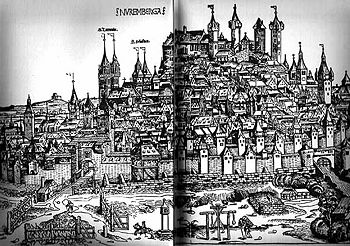Nuremberg Chronicle
The Nuremberg Chronicle (Liber Chronicarum in Latin; Schedelsche Weltchronik, in German) was published in 1493 by Hartmann Schedel and is an illustrated history of the earth dating from creation to the 1490's. The chronicle is one of the most well-documented incunabula (publication prior to 1501) because many of its contracts are still extant.
It was originally published in Latin as the Liber Chronicarum and translated by George Alt in 1493. There are 1809 prints made from 645 woodcuts. It was illustrated and engraved by Michael Wolgemut and Wilhelm Pleydenwurff, house designers of the publisher Anton Koberger. It details the history of the world as given as the Bible, and also includes descriptions of major Western cities, geneaologies, and descriptions of great disasters.
Production of the chronicle was funded by wealthy Nuremberg citizens Sebald Schreyer and Anton Kamermeister, and the chronicle was intended to showcase the artistry and wealth of the city.
Contracts for the production of the Nuremberg Chronicle were drawn up in late 1487 or early 1488 for Wolgemut and Pleydenwurff to illustrate Schedel's chronicle, which he was still writing at the time, to be published by Anton Koberger. The formal contract restated on 29 December 1491.[1]
Anton Koberger published for the northern European market in biblical and devotional texts. The Nuremberg Chronicle is the most prominent example of his taste for creating major, elaborate productions in both Latin and in the vernacular. Koberger's process for the illustration of the Chronicle set a new standard for specialised woodcut making in northern Europe. The contract agreements show that the publication of the book was funded independently of the printer, with Koberger's role as job printer meaning he would have no direct liability for the project's success or failure. The draftsmen Wolgemut and Pleydenwurff had the status of near equal partners, in that their profits would derive not from needing to provide any capital for the initial project but that they would contribute by providing the woodcut illustrations and would not retain their rights to their designs. These contractural agreements were new innovations in major publication projects, and preceded the eventual practice of publishing houses taking control of their productions.[2]
The contracts also specified that Koberger was to set aside a locked room for storing the woodblocks in order to prevent theft, however security precautions did not stop a pirated version of the chronicle being printed by Augsburg publisher Hans Schönsperger in 1496.
Binding and colouring of the Chronicle was not included in the initial publication contract. An unbound and uncoloured copy of the Chronicle sold for 2 gulden, determined to be the equivalent of buying 120 pounds of beef at prices for the year 1500.[3] At final settlement on 22 June 1509, when investors and artists were given their returns based on their investments, 509 Latin and 49 German copies remained unsold.
